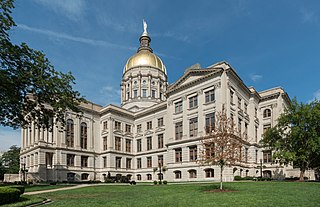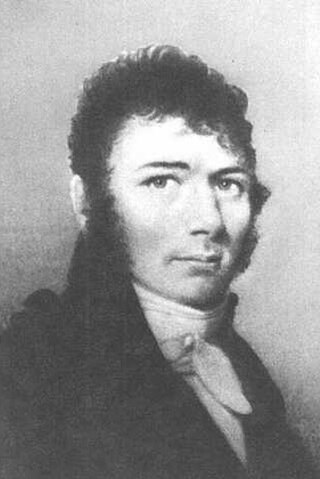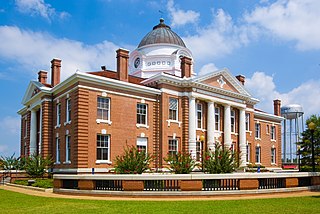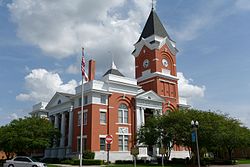
A courthouse or court house is a structure which houses judicial functions for a governmental entity such as a state, region, province, county, prefecture, regency, or similar governmental unit. The term in insular british usage, and by extension, to the former colonies of the british empire, gradually superseded the term moot hall, or meeting hall, during the later half of the middle ages and early modern period, as these buildings housed the local or regional courts. The term court was introduced into english as a french loanword as couer meaning heart, as these buildings were considered to be at the heart of local judicial and administrative business. In most of continental Europe and former non-English-speaking European colonies, the equivalent term is a palace of justice.

Bulloch County is a county located in the southeastern part of the U.S. state of Georgia. As of the 2020 census, the population was 81,099, up from 70,217 in 2010. The county seat is Statesboro. Bulloch County comprises the Statesboro, GA Micropolitan Statistical Area, which is included in the Savannah–Hinesville–Statesboro Combined Statistical Area.

Statesboro is the largest city and county seat of Bulloch County, Georgia, United States. Located in the southeastern part of the state, its population was 33,438 at the 2020 census. It is the principal city of the Statesboro micropolitan area, which had 81,099 residents, and is part of the Savannah–Hinesville–Statesboro combined statistical area.

The Georgia State Capitol is an architecturally and historically significant building in Atlanta, Georgia, United States. The building has been named a National Historic Landmark which is listed on the National Register of Historic Places. As the primary office building of Georgia's government, the capitol houses the offices of the governor, lieutenant governor, and secretary of state on the second floor, chambers in which the General Assembly, consisting of the Georgia State Senate and Georgia House of Representatives, meets annually from January to April. The fourth floor houses visitors' galleries overlooking the legislative chambers and a museum located near the rotunda in which a statue of Miss Freedom caps the dome.

The United States District Court for the Southern District of Georgia is a federal court in the Eleventh Circuit.
Josiah Tattnall was an American planter, soldier and politician from Savannah, Georgia. He represented Georgia in the U.S. Senate from 1796 to 1799, and was the 25th Governor of Georgia in 1801 and 1802. Born near Savannah, Georgia, at Bonaventure Plantation in the early 1760s to Mary Mullryne and Josiah Tattnall, he studied at Eton School before joining Anthony Wayne's troops at Ebenezer during the American Revolutionary War. After the war, he was elected brigadier general of the 1st Regiment in the Georgia Militia. He helped to rescind the Yazoo land fraud of 1795. He died in Nassau, New Providence.

Mercer University School of Law is the professional law school of Mercer University. Founded in 1873, it is one of the oldest law schools in the United States; the first law school accredited by the bar in Georgia, and the second oldest of Mercer's 12 colleges and schools. The School of Law has approximately 440 students and is located in Macon, Georgia on its own campus one mile (1.6 km) from Mercer's main campus. The law school building, one of Macon's most recognizable sites, is a three-story partial replica of Independence Hall in Philadelphia and is located on Coleman Hill overlooking downtown Macon. According to Mercer's official 2020 ABA-required disclosures, 72% of the Class of 2020 obtained full-time, long-term, JD-required employment nine months after graduation.

Daniel Stewart was an American politician and brigadier general in the Georgia Militia. He joined the militia in 1776 and served during the American Revolutionary War and the War of 1812.
William Augustus Edwards, also known as William A. Edwards was an Atlanta-based American architect renowned for the educational buildings, courthouses and other public and private buildings that he designed in Florida, Georgia and his native South Carolina. More than 25 of his works have been listed on the National Register of Historic Places.

The Donehoo-Brannen House is a historic house located at 332 Savannah Avenue in Statesboro, Georgia.

The Elbert P. Tuttle U.S. Court of Appeals Building, also known as U.S. Post Office and Courthouse, is a historic Renaissance Revival style courthouse located in the Fairlie-Poplar district of Downtown Atlanta in Fulton County, Georgia. It is the courthouse for the United States Court of Appeals for the Eleventh Circuit.

The Historic Fairfax County Courthouse is one of the oldest buildings in Fairfax, Virginia. It was constructed in 1799 to serve as the seat of government in Fairfax County. During the American Civil War, the first Confederate officer casualty of the war took place on the courthouse grounds and the building was occupied by both sides in the conflict. Today, the original courthouse building is part of the larger courthouse site that serves the local government of Fairfax County.

Bruce & Morgan was an American architectural firm based in Atlanta. It was established in 1882 as the partnership of architects Alexander Campbell Bruce (1835-1927) and Thomas Henry Morgan (1857-1940).

The Early County Courthouse is the historic county courthouse of Early County, Georgia, located on Courthouse Square in Blakely, Georgia, the county seat. It was built in 1904 and added to the National Register of Historic Places on September 18, 1980. It is also a contributing building in the Blakely Court Square Historic District, NRHP-listed in 2002.
The Statesboro City Hall and Fire Station is a historic structure in Statesboro, Georgia. It is located at the corner of Siebald Street and Courtland Street, immediately northeast of the courthouse square. It is a one-story brick building of commercial design. It was built in 1911 as the city stables and remodeled several times. In 1933 there was a major addition and the whole structure may have been rebuilt. The city government and fire department once occupied this building. An awning was added before 1966 and a vehicle bay was added in 1970.

The Statesboro Regional Public Libraries (STRL) is a public library system that supports the counties of Bulloch, Bryan, Candler, Emanuel, and Evans Georgia. The central library is located in Statesboro, Georgia.

The West Main Street Commercial Historic District is a historic district consisting of five brick buildings in downtown Statesboro, Georgia that were built between 1905 and 1923 and that hold a total of 16 storefronts. It was listed on the National Register of Historic Places in 1989.

The James Alonzo Brannen House is a house built in 1881 in Statesboro, Georgia. It is notable as the oldest residence in the town and for its association with lawyer J. A. Brannen (1858-1923), for whom it was built, and who served as the town's first mayor.

The lynching of Paul Reed and Will Cato occurred in Statesboro, Georgia on August 16, 1904. Five members of a white farm family, the Hodges, had been murdered and their house burned to hide the crime. Paul Reed and Will Cato, who were African-American, were tried and convicted for the murders. Despite militia having been brought in from Savannah to protect them, the two men were taken by a mob from the courthouse immediately after their trials, chained to a tree stump, and burned. In the immediate aftermath, four more African-Americans were shot, three of them dying, and others were flogged.



















